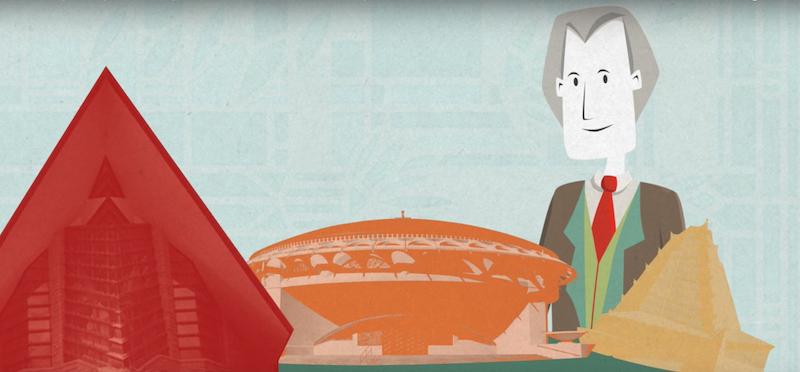Whether you agree with Frank Lloyd Wright’s definition of good architecture or not, the late architect was never anything less than resolute and unswerving in his convictions. If ever you needed evidence of this, look no further than PBS Digital and Quoted Studios’ Blank on Blank animated short featuring excerpts from an interview between Wright and Mike Wallace in 1957.
In the short six-minute video, Wright calls architecture of the past 500 years “phony,” says, if given another 15 years to work, he would rebuild the country and change the nation, and casts aspersions on the New York City skyline calling it a “great monument to money and greed.” Wright certainly doesn’t hold anything back in this interview, but before anyone gets any ideas to call him arrogant, he has a few choice words for you too. “I think any man who really has faith in himself will be dubbed arrogant by his fellows,” Wright says. “I think that’s what happened to me.”
Wright’s interview on The Mike Wallace Show took place when he was 90 years old, just two years before his death. At this point in his life, Wright had designed over 1,000 buildings and had seen over 500 of them come to fruition, but even with so much work under his belt, Father Time was the only thing slowing the 90-year-old architect down and hindering him from accomplishing more.
Returning to his idea of changing the country, Wallace quoted Wright as previously saying, “If I had another 15 years to work, I could rebuild this entire country. I could change the nation.” Wright confirmed that he said this saying, “It’s amazing what I could do for this country. I wouldn’t start to change so much the way we live, as what we live in and how we live in it.”
Wright wasn’t the only architect featured in a Blank on Blank video. A 1965 interview between architect Buckminster Fuller and Studs Terkel was also turned into an episode.
Fuller’s interview isn’t quite as provocative as Wright’s, but he shares some of the same ideas as Wright regarding the current state of architecture. “I saw that the way in which we built was very, very ignorant,” Fuller says.
The rest of the video gives some insight into how and why Fuller developed his architectural style and philosophy.
Both videos act as windows into the minds and imaginations of two architects with very unique and very ambitious ideas for what architecture could and should be.
According to Quoted Studios, its purpose in creating these animated videos from interviews, such as this one featuring Wright and Wallace, is to unlock hidden stories. “Whether they’re interviews sitting on a journalist’s tapes or in a major archive, recordings buried in a media brand’s archives, or the yet to be heard stories within an organization, we transform raw, intimate storytelling into culturally resonant digital content,” the company writes on its website.
Other notable figures featured in the Blank on Blank series include Rod Serling, Ayn Rand, Ray Bradbury, and Carl Sagan.
Related Stories
Building Team | Feb 24, 2015
Call for entries: 2015 Giants 300 survey
The annual Giants 300 Report ranks the top AEC firms in commercial construction, by revenue.
Industrial Facilities | Feb 24, 2015
Starchitecture meets agriculture: OMA unveils design for Kentucky community farming facility
The $460 million Food Port project will define a new model for the relationship between consumer and producer.
University Buildings | Feb 23, 2015
Future-proofing educational institutions: 5 trends to consider
In response to rapidly changing conditions in K-12 and higher education, institutions and school districts should consider these five trends to ensure a productive, educated future.
Office Buildings | Feb 23, 2015
The importance of quiet and the consequences of distraction
Recent work style studies show that the average knowledge worker spends 25-35% of their time doing heads-down focused work. Once thrown off track, it can take some 23 minutes for a worker to return to the original task.
Modular Building | Feb 23, 2015
Edge construction: The future of modular
Can innovative project delivery methods, namely modular construction, bring down costs and offer a solution for housing in urban markets? FXFOWLE’s David Wallance discusses the possibilities for modular.
| Feb 23, 2015
6 trends changing the way city dwellers live
Across the cultural grid, from food to retail to transportation, America's urban areas are already undergoing a major metamorphosis. Here are the six major trends shaping our cities, from Fast Company.
Green | Feb 23, 2015
State of the green union, and the next big shift in sustainability
The history of the green movement offers cues that we are on the precipice of another significant shift in the green union.
| Feb 23, 2015
Where are the iconic green buildings?
What does a green building look like? How would you know one if you saw one? Maybe a trivial question to some, but of great interest to architects, designers, and other members of the Building Team as the rapid evolution of sustainable buildings continues apace.
Sports and Recreational Facilities | Feb 21, 2015
Pumped-up recreation centers help build body, mind, and spirit
Adopting facility layouts from Asian and European models, today’s sports and recreational buildings are becoming social hubs that accommodate a variety of community needs.
University Buildings | Feb 20, 2015
Penn strengthens campus security by reviving its surrounding neighborhood
In 1996, the University of Pennsylvania’s sprawling campus in Philadelphia was in the grip of an unprecedented crime wave. But instead of walling themselves off from their surrounding neighborhoods, the school decided to support the community.















